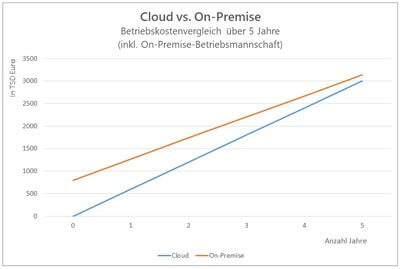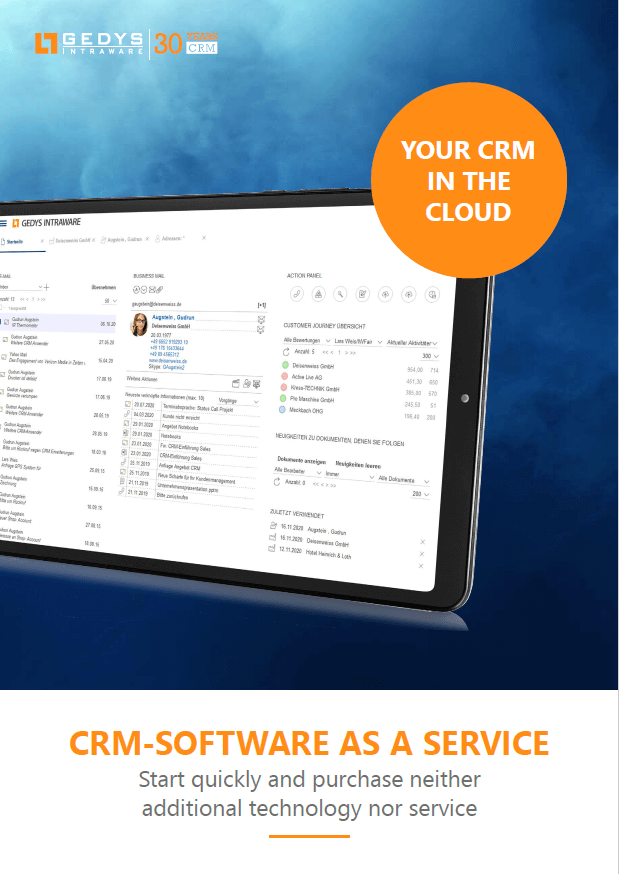Better Cloud or On-Prem?
Advantages & Disadvantages of the 6 Relevant Factors for a Decision
Cloud or On-Prem (also cloud computing and on-premises) are two licensing and usage models for server-based computer programs. Until about 2010, the longer-existing on-prem model was the predominantly used one. Since the introduction of cloud technology, however, some have been concerned with the question of which model is the better when it comes to new acquisitions, for example a CRM software.
Let us get to the bottom of the question.
Table of Contents
What does On-Premises mean?
In the on-premises model, the licensee buys or rents the software. He operates these independently in the in-house data center or on specially rented servers of an external data center. He therefore additionally buys or rents the hardware needed to provide the software for the corresponding number of users in his company and to store the resulting data.
In addition, the in-house system (i.e. its own data center) requires an IT team to take care of updates and maintenance of the servers and data.
What is cloud computing?
In cloud computing, for example, the licensee obtains the CRM software entirely as a service. Hence the name Software-as-a-Service (SaaS). But it only works with a cloud CRM. Do you also read the blog article Is it also available as CRM-SaaS?
Hardware, operating and infrastructure costs as well as maintenance costs are entirely at the supplier’s expense and are therefore transparently included in the rental price for the customer. Often such contracts are concluded on a usage or period-by-period basis. This allows the licensee to have a high degree of flexibility when booking usage licenses or storage space as needed
Cloud or On-Prem: Which fits better to your company?
Which model offers more flexibility?
Flexibility here refers on the one hand to the adaptability of the software to individual business models and business processes, on the other hand to the capacity for users and data storage.
On-Prem offers a big advantage in terms of software customization: In-house or external developers can make company-specific necessary changes to the purchased software themselves, instead of commissioning it from the manufacturer. Depending on the use of resources, it is possible to save time and costs. The disadvantage is, that updates by the software vendor may not apply these changes.
In the case of cloud solutions, customization options for the software can usually be realized within the service via configurations or optionally bookable modules (possibly also by third parties). Smaller, personal requirements can often be set by the user himself (see example CRM simply configure yourself).
However, adjustments cannot usually be made to the extent that individual on-prem offers are possible. But you always have the latest version of the software available.
For on-prem solutions, expanding the storage space involves hardware acquisition, which is expensive and potentially costly. Cloud computing can easily expand or reduce storage space and user licenses, but not without costs either. Nevertheless, this can offer enormous benefits for agile responses to changing market conditions.
For this purpose, the on-prem solution usually has lower latency (latency = the time it takes a data packet from its starting point to the destination) with appropriate bandwidth. In addition, offline use of the application is possible without any problems. User licenses are as easy to add or debit depending on the license model as they are with a cloud solution.
The biggest positive aspect of cloud technology is that it enables completely new business models,for example in the field of IoT (Internet of Things), AI (Artificial Intelligence) or Machine Learning.
Cloud or On-Prem: A comparison of the two models.
| The 6 factors: | On-premises model | Cloud computing model |
|---|---|---|
| Purchase | Hardware, software, infrastructure Additionally necessary: operation & maintenance high costs various providers | all included in the rental price no extra costs only one provider |
| Licenses | Licenses per user and per product to buy as needed Relay prices for products and users | Licenses per user for total package bookable as required Rental prices staggered according to use or time |
| Space | additional hardware acquisition Other costs | Storage space bookable as needed Rental price is adjusted accordingly |
| Adjustments | by internal or external developers Cost amount and amount of time depending on of resource inatz | Configurations or module selection optionally possible Rental price depends on scope |
| Updates | after longer time intervals Adjustments are not applied | automatic updates Configurations are preserved |
| Privacy | High security Own control & monitoring | Providers with data center in Germany = GDPR compliant |
What about data protection?
When it comes to data protection, On-Prem has been seductive since the EU GDPR at the latest. Through in-house storage, the company has full control over data management and security. Therefore, this solution is particularly popular with business models that require particularly high data security.
Nevertheless, cloud solutions also provide security. However, with regard to the EU GDPR, attention should be paid to where the servers are located. It is best to choose a provider in Germany,as the latter must comply with the German Data Protection Ordinance. Our cloud CRM already fulfills this task.
What are the costs?
The cost comparison of on-premises and cloud computing needs to be considered in a differentiated way. Ongoing IT costs of internally managed data centers are often underestimated. Only the one-time acquisition costs of the hardware are calculated and the administrative burden for an in-house system is not taken into account.
The results of a cost comparison are thus quickly distorted.

Source: computerwoche.de
Moreover, the costs must not be considered alone. Company-specific requirements for stability, flexibility, agility, or scale, as well as the willingness to restructure organizationally that leads to a transition to cloud systems, play an equally important role in deciding for or against a model.
The alternative: Hybrid systems
In the meantime, the trend is increasingly emerging not to simply choose one option or another. More and more often, the decision is made on so-called hybrid systems. Typically, the robust resources of a cloud are exploited for good performance and sensitive data is stored on internal servers.

